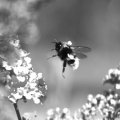Federal Minister for Science and Technology Peter McGauran had a close encounter of the venomous kind when he visited the University of Queensland on May 1.
Mr McGauran met some of the world's deadliest terrestrial snakes, cone shells and funnel web spiders at the University's Centre for Drug Design and Development.
His half-day campus visit also included meeting researchers from the space engineering research group in the University's Mechanical Engineering Department.
The Centre for Drug Design and Development is currently expanding its efforts in venom research, particularly as it relates to new drug development.
Centre director Professor Peter Andrews said Australia was the only developed country among the world's 12 megadiverse countries.
'Australia's biological diversity is rich and unique,' Professor Andrews said.
'At the species level, 90 percent of our mammals, 88 percent of our reptiles, 70 percent of our birds and 85 percent of our southern temperate fish are endemic to Australia. Less than 10 percent of our microorganisms have been described.
'We also have some of the world's most venomous species, and we are in an ideal position to study these species and their toxins first-hand.'
Professor Andrews said the Centre was particularly interested in the many components of animal venoms (from snakes, spiders, cone shells and scorpions) which had highly specific activities or physiological targets.
'Their high specificity makes them ideal tools to unravel the complexity of nerve transmission and basic molecular mechanisms. It also makes many venoms important leads to new drugs,' he said.
Professor Andrews said the Centre's venom research program had initially focused on toxins from Australian cone shells.
Work over the past three years had led to a unique knowledge base, including a large library of crude venoms and venom duct tissues, several previously unknown peptide frameworks, numerous high resolution magnetic resonance structures and the first four cone toxin crystal structures. The Centre had also chemically synthesised 50 toxins from cone shells.
Professor Andrews said recently, the Centre had expanded its studies to include other venomous species such as funnel web, trap-door and mouse spiders, land and sea snakes, and insects such as ants, scrub ticks, bees and wasps.
'Initial work on the Sydney funnel web spider's venom indicates the venom contains 30-60 components, and we have found several neurotoxins in the venom that have novel sequences and structures,' he said.
This year the Centre commenced an intensive characterisation of venoms from Australia's most dangerous snakes.
It also has an active collaboration with the Royal North Shore Hospital in Sydney on jumper ant venom, and another with the University of Technology, Sydney to investigate the neurotoxin produced by the scrub tick - the first identified from a tick. Future work would investigate other venom components.
Professor Andrews said more than 1000 species of ants had been described in Australia, while more than 100 species of native bees and wasps had venoms awaiting investigation.
He said 30 Centre scientists were currently conducting different aspects of toxin and venom research, including 11 working full-time on cone shell toxins.
'Most of this group's effort is directed towards discovering and characterising novel toxin frameworks and sequences, but their work also intersects with our major research programs targeting general strategies for synthesising new potential candidates for drug development,' he said.
For further information, contact Professor Andrews, telephone 07 3365 1276.



